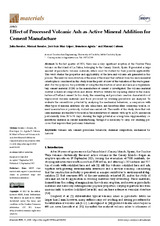Mostrar el registro sencillo del ítem
Effect of Processed Volcanic Ash as Active Mineral Addition for Cement Manufacture
| dc.contributor.author | Rosales, Julia | |
| dc.contributor.author | Rosales, Manuel | |
| dc.contributor.author | Díaz-López, José Luis | |
| dc.contributor.author | Agrela Sáinz, Francisco | |
| dc.contributor.author | Cabrera, Manuel | |
| dc.date.accessioned | 2022-09-12T07:47:50Z | |
| dc.date.available | 2022-09-12T07:47:50Z | |
| dc.date.issued | 2022 | |
| dc.identifier.uri | http://hdl.handle.net/10396/23854 | |
| dc.description.abstract | In the last quarter of 2021, there was a very significant eruption of the Cumbre Vieja volcano on the island of La Palma, belonging to the Canary Islands, Spain. It generated a large amount of pyroclastic volcanic materials, which must be studied for their possible applicability. This work studies the properties and applicability of the lava and volcanic ash generated in this process. The need for reconstruction of the areas of the island that suffered from this environmental catastrophe is considered in this study from the point of view of the valuation of the waste generated. For this purpose, the possibility of using the fine fraction of ashes and lava as a supplementary cement material (SCM) in the manufacture of cement is investigated. The volcanic material showed a chemical composition and atomic structure suitable for replacing clinker in the manufacture of Portland cement. In this study, the cementing and pozzolanic reaction characteristics of unprocessed volcanic materials and those processed by crushing procedures are analysed. To evaluate the cementitious potential by analysing the mechanical behaviour, a comparison with other types of mineral additions (fly ash, silica fume, and limestone filler) commonly used in cement manufacture or previously studied was carried out. The results of this study show that volcanic materials are feasible to be used in the manufacture of cement, with up to a 22% increase in pozzolanicity from 28 to 90 days, showing the high potential as a long-term supplementary cementitious material in cement manufacturing, though it is necessary to carry out crushing processes that improve their pozzolanic behaviour. | es_ES |
| dc.format.mimetype | application/pdf | es_ES |
| dc.language.iso | eng | es_ES |
| dc.publisher | MDPI | es_ES |
| dc.rights | https://creativecommons.org/licenses/by/4.0/ | es_ES |
| dc.source | Materials 15(18), 6305 (2022) | es_ES |
| dc.subject | Volcanic ash | es_ES |
| dc.subject | Cement | es_ES |
| dc.subject | Pozzolanic behaviour | es_ES |
| dc.subject | Chemical composition | es_ES |
| dc.subject | Mechanical behaviour | es_ES |
| dc.title | Effect of Processed Volcanic Ash as Active Mineral Addition for Cement Manufacture | es_ES |
| dc.type | info:eu-repo/semantics/article | es_ES |
| dc.relation.publisherversion | https://doi.org/10.3390/ma15186305 | es_ES |
| dc.relation.projectID | Gobierno de España. PID2019-107238RB | es_ES |
| dc.rights.accessRights | info:eu-repo/semantics/openAccess | es_ES |

